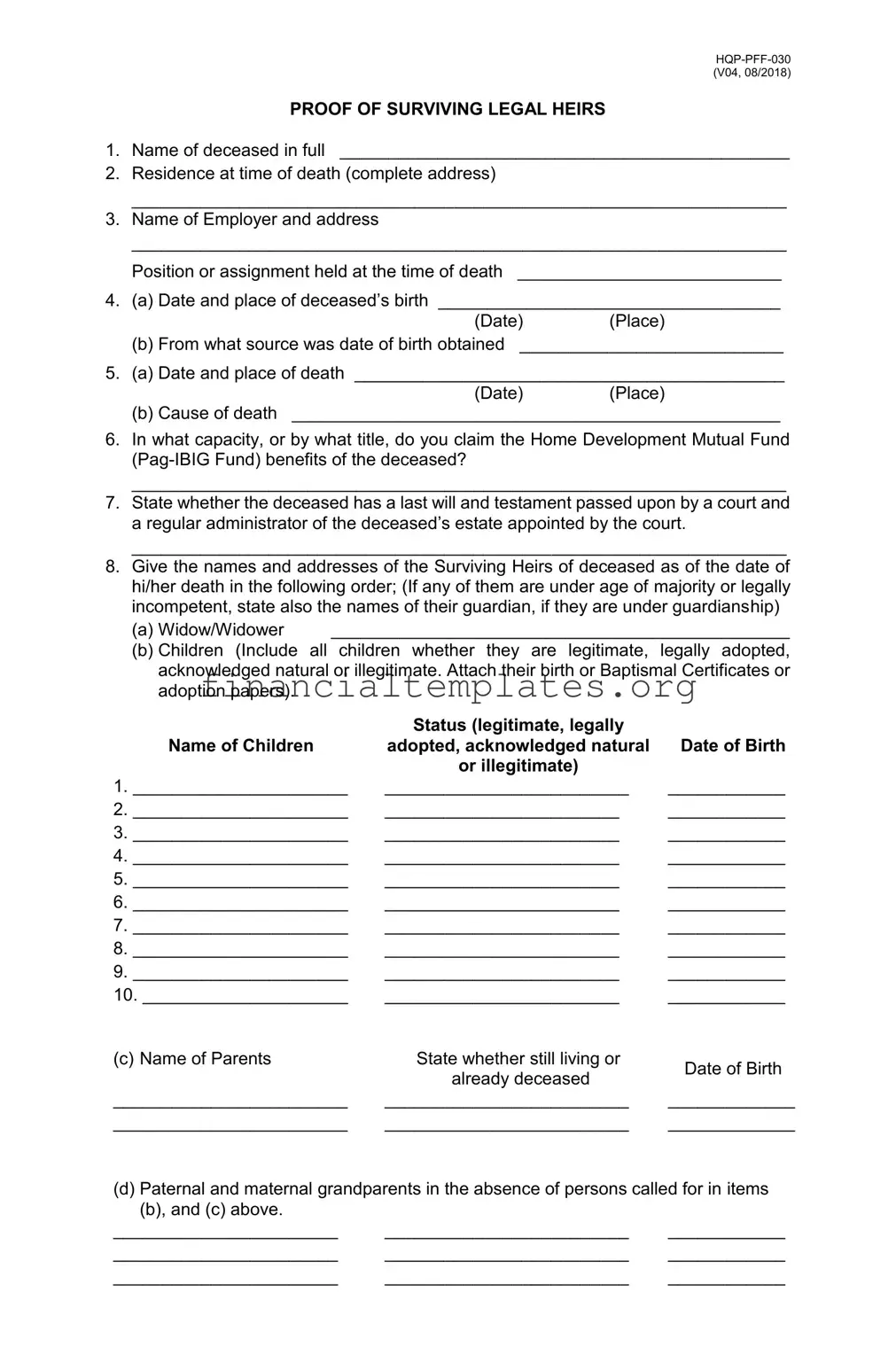HQP-PFF-030 (V04, 08/2018)
PROOF OF SURVIVING LEGAL HEIRS
1.Name of deceased in full ______________________________________________
2.Residence at time of death (complete address)
___________________________________________________________________
3.Name of Employer and address
___________________________________________________________________
Position or assignment held at the time of death ___________________________
4.(a) Date and place of deceased’s birth ___________________________________
(Date) (Place)
(b) From what source was date of birth obtained ___________________________
5. (a) Date and place of death ____________________________________________
(Date) (Place)
(b)Cause of death __________________________________________________
6.In what capacity, or by what title, do you claim the Home Development Mutual Fund (Pag-IBIG Fund) benefits of the deceased?
___________________________________________________________________
7.State whether the deceased has a last will and testament passed upon by a court and a regular administrator of the deceased’s estate appointed by the court.
___________________________________________________________________
8.Give the names and addresses of the Surviving Heirs of deceased as of the date of hi/her death in the following order; (If any of them are under age of majority or legally incompetent, state also the names of their guardian, if they are under guardianship)
(a)Widow/Widower _______________________________________________
(b)Children (Include all children whether they are legitimate, legally adopted, acknowledged natural or illegitimate. Attach their birth or Baptismal Certificates or adoption papers).
|
Status (legitimate, legally |
|
Name of Children |
adopted, acknowledged natural |
Date of Birth |
|
or illegitimate) |
|
1. ______________________ |
_________________________ |
____________ |
2. ______________________ |
________________________ |
____________ |
3. ______________________ |
________________________ |
____________ |
4. ______________________ |
________________________ |
____________ |
5. ______________________ |
________________________ |
____________ |
6. ______________________ |
________________________ |
____________ |
7. ______________________ |
________________________ |
____________ |
8. ______________________ |
________________________ |
____________ |
9. ______________________ |
________________________ |
____________ |
10. _____________________ |
________________________ |
____________ |
(c) Name of Parents |
State whether still living or |
Date of Birth |
|
already deceased |
|
|
________________________ |
_________________________ |
_____________ |
________________________ |
_________________________ |
_____________ |
(d)Paternal and maternal grandparents in the absence of persons called for in items (b), and (c) above.
_______________________ |
_________________________ |
____________ |
_______________________ |
_________________________ |
____________ |
_______________________ |
_________________________ |
____________ |
HQP-PFF-030 (V04, 08/2018)
(e)Brothers and sisters in the absence of persons called for in items (b), (c) and (d) above. (Use another sheet if necessary)
|
Name of |
Age |
Address |
Guardian of |
|
Brother/Sister |
Minors |
|
|
|
|
1. ___________________ |
_______ |
___________________ |
______________ |
|
2. ___________________ |
_______ |
__________________ |
______________ |
|
3. ___________________ |
_______ |
___________________ |
______________ |
(f)Children of deceased brother/s and sister/s. (State age, address and guardian of minors). This is required only in the absence of items (b), (c) and (d) above.
______________________________________________________________________
______________________________________________________________________
______________________________________________________________________
______________________________________________________________________
(g)Other relatives. (State relationship to deceased)
______________________________________________________________________
______________________________________________________________________
The |
undersigned |
hereby make/s |
claim |
to the |
Pag-IBIG Fund |
Provident |
Benefits |
Claim/Insurance |
Claim |
of |
the |
deceased |
___________________________ and declare, confirm, affirm and agree that the written
statements and affidavits and all other papers called for the instructions hereon shall constitute declaration, confirmation and affirmation and they are hereby made a part of this Proof of Surviving Legal Heirs and further declare, confirm, affirm and agree that the furnishing of this form or any other forms supplemented thereto, to said Pag-IBIG Fund shall not constitute nor be considered an admission by the Pag-IBIG Fund that the deceased is entitled to the Provident Benefits Claim/Insurance Claim under PD 1530 (As amended by Executive Order Nos. 527 and 538), PD 1752 (As amended by Executive Order Nos. 35 and 90, and Republic Act No. 7742), and RA 9679; nor a waiver of any of its right or defenses.
_____________________ |
_______________________ |
____________________ |
CLAIMANT |
CLAIMANT |
CLAIMANT |
ID No. _______________ |
ID No. ________________ |
ID No. ______________ |
Valid until ____________ |
Valid until _____________ |
Valid until _____________ |
With my marital consent: |
|
|
_____________________ |
______________________ |
______________________ |
SPOUSE |
SPOUSE |
SPOUSE |
SIGNED IN THE PRESENCE OF:
_______________________________ ______________________________
HQP-PFF-030 (V04, 08/2018)
A C K N O W L E D G M E N T
REPUBLIC OF THE PHILIPPINES |
)S.S. |
PROVINCE/CITY OF ______________) |
|
BEFORE ME, a Notary Public for and in the ____________________________,
Province of ________________________, this _____ day of ____________, 20_____,
personally appeared the above-named person/s, who has satisfactorily proven to me his/her/their identity through his/her/their identifying documents written below his/her/their name and signature, that they are the same person/s who executed and voluntarily signed the foregoing Proof of Legal Heirs, duly signed by his/her/their instrumental witnesses at the spaces herein provided which he/she/they acknowledged to me as his/her/their free and voluntary act and deed.
The foregoing instrument relates to a Proof of Surviving of Legal Heirs consisting of ________ (___) pages including the page on which this Acknowledgment is written,
has been signed on the left margin of each and every page by the parties and the witnesses.
WITNESS MY HAND AND NOTARIAL SEAL, this ______ day of
_____________, 20_____, in the _____________________________, Province of
____________________.
NOTARY PUBLIC
Doc. No. ____________;
Page No. ____________;
Book No. ____________;
Series of ____________.
